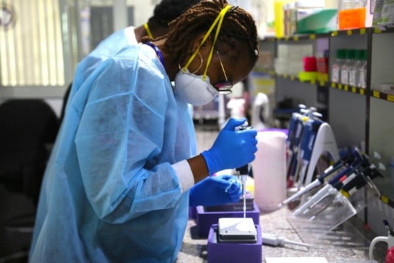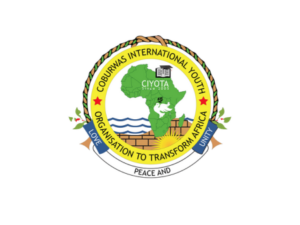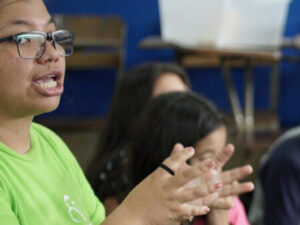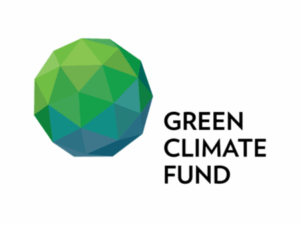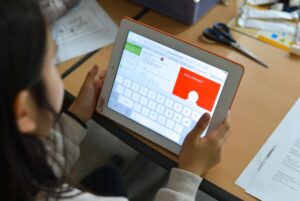The African Center of Excellence for Genomics of Infectious Diseases is a platform for training the next generation of African genomic scientists and contributing to the understanding of circulating health threats, as well as effective outbreak preparedness and response.
Christian Happi of African Center of Excellence for Genomics of Infectious Diseases spoke with Lissa Harris on December 15, 2023. Click here to read the full conversation with insights highlighted.
Lissa Harris: Can you start by introducing yourself and your organization, and talk broadly about the problem that you’re working on and how you’re trying to solve it?
Christian Happi: I’m a distinguished professor of Molecular Biology and Genomics, and the founder and the director of the African Center of Excellence for Genomics of Infectious Disease at Redeemer’s University. This center, founded in 2013, has been addressing the issues related to infectious diseases, and specifically epidemics, in Africa. We’ve been involved in multiple epidemics and transforming outbreak and epidemic response based on some innovations that we brought on board, starting with the West African Ebola outbreak in 2014.
So we’ve been in this space for almost a decade. We are a pretty young organization, but I think people often think that we’re old, because of the impact that we’ve made and the transformation we’ve brought into the field with our approaches to infectious disease research in Africa, and also issues related to capacity-building, and training and infrastructure development.
Lissa Harris: Who do you work with most directly? Who are the people that you’re serving and how do you engage with them? Who benefits from your work?
Christian Happi: The people that benefit from my work are primarily the patients, and then indirectly the clinical team working with those patients, and then the government – at local level, at national level and at the level of the continent of Africa. We believe that we have been able to impact very positively not only these patients, but in a very transformative way we’ve impacted the whole of the continent and the global health community.
Lissa Harris: How specifically do you engage with people? How do you work with the people who are benefiting from your work?
Christian Happi: We first of all identify problems, and then we need to work with the community and identify what the issues are, and then discuss with them and see what solutions are needed. So we’re more solution-oriented. Then we can look for resources and bring the solution closer to the patients in a way that we can directly impact their lives, and then also transform the way, for instance, those patients are managed in their communities.
Let me start with one example. In 2007 a disease called Lassa Fever, that was described in Nigeria in 1969, had no diagnostics in Nigeria – what we call a molecular diagnosis, a way to detect that disease, there was none. We identified that and then, leaving my very pristine laboratory at Harvard, I flew down to a very rural community in Nigeria where the epicenter was, where this disease recurred on an annual basis and killed people.
I went there on a fact-finding mission. I was able to see doctors managing patients. I was able to see patients. I was able to see people that lost family members to the Lassa Fever virus, and to identify that one of the major issues is that even when people are sick with the disease, they don’t know because it comes up like malaria, it comes up like typhoid fever. It starts with a fever but by the time they’re going to the hospital to get a diagnosis, not only is the diagnosis not available, but it’s often too late. So the question was: what can we do to put in place a diagnosis that can let people know early enough so they can get treated?
This is a disease that can be treated with the molecule called Ribavirin, but when a patient reports late, that molecule is often not effective. So how do we bring diagnosis closer to the patient? We went back and used the partial sequence of the virus that was available at the time to create the molecular diagnostics. And we brought the molecular diagnostics with equipment and the tools to do the diagnostics in a very rural hospital in Nigeria, and we did the very first molecular diagnostics in Nigeria at the time, trained people on the ground to do the diagnostics.
And then things changed around. Simply because, by bringing the diagnostic close to the patient, two things happen. In that same hospital every year they used to lose about five medical personnel due to this virus. From the day we brought the diagnostics into the hospital until today, they haven’t lost a single staff due to that. Because anytime the staff feels a bit febrile, they can go to the testing center and get tested for free, and they know whether they have Lassa Fever early enough and they get managed, and then recover.
The second thing is the fact that samples used to be collected from Nigeria, sent to Germany, and then the results come back three weeks or a month after, and wit] the case fatality rate at the time, 90% of the people that had their samples shipped to Germany would’ve died at the time. But by testing people on the ground, we brought down the case fatality rate from 90%, to 23.7% as I’m speaking. That tells you exactly how identifying a social problem and taking the solution close to the patients can not only directly affect patient management, but also positively impact the community.
Now, the other thing that happened is that many people with the disease in the rural community surrounding the hospital were not willing to go to the hospital because they considered it a graveyard – that when you go there, you don’t come back alive. They felt that maybe it was the hospital that was even killing them. But because there were diagnostics and we went and sensitized people, people started coming to the hospital, they were diagnosed, and then they were managed, treated and recovered. That really boosted the confidence in the communities around to go to hospital when they feel bad. That created a situation whereby the suspicion by the communities toward the hospital was broken.
Lissa Harris: I was going to ask you for an example that illustrates impact, and that’s a pretty dramatic one. What do you think makes your approach distinctive from other organizations that are working in this space and on similar problems?
Christian Happi: I think what makes it a bit different is that we are an organization that is in Africa, that is invested in identifying and solving problems within the continent. We don’t parachute in just when there’s a problem. We’re in, we live within those communities. We discuss with the communities, we know exactly what their problems are, and we also discuss what they believe the solutions could be.
I will take another example, let’s take the Ebola outbreak in 2014. When that outbreak started in the confinement of Guinea in 2013, when the whole world was looking away, I was very worried and very scared, knowing the situation on the ground, that this disease will spread across the continent simply because borders across the African continent are very porous. Families live across borders, you can’t prevent somebody on the other part of the road from crossing over to this part. I suspected that this was going to spread and then it was going to be difficult to stop it if we do not act on time. But then moving around and discussing with the people, discussing with the doctors, you realize that one of the major limiting factors to contain that epidemic at the time – something that was growing in Guinea and would spread across Africa and eventually wipe out a good number of people on this continent – was lack of diagnostics. Because you cannot manage the disease if you cannot diagnose it correctly.
What we did was to actually go and train somebody in [neighboring] Sierra Leone, because we were working in Sierra Leone on Lassa Fever, and trained them how to detect Ebola by molecular diagnostics. We also trained people in Nigeria in our lab. We stocked the labs in Kenya, in Sierra Leone with PPEs and the diagnostics and everything that was needed. We did the same for Nigeria. And, as we rightly predicted, the disease eventually spilled over from Guinea to Sierra Leone. The young man, Augustine Goba, that we trained was the first person to do the first detection of Ebola in Sierra Leone, based on the diagnostic technique that we trained him on, and also based on the fact that he had the protective kits.
Then we activated our contact-tracing mechanism that we use for Lassa Fever, for instance, to trace, in the first week of that outbreak in Sierra Leone, the first 31 patients, confirmed 14 out of them, and then we were able to identify the index patient who was that person to which other people got contacted. It was a traditional healer. He died along the line, but the bottom line is that we were able to get down to the index patient and to the source. That contact-tracing mechanism enabled us to start tracing how this thing was spreading. But we’re able to do that because we’re boots on the ground. We knew exactly what the situation was, and we helped the situation in Sierra Leone as much as we could before we started having the whole world parachuting and then disrupting the process that we had put in place.
[Meanwhile in] Nigeria, because we had very strong communication with the national public health system, the first suspected case in Nigeria was reported and the sample was sent to us, and within six hours we were able to establish that we had Ebola in the country. Immediately after we did that, we were able to communicate with national public health authorities and then they took rapid decisions: isolating the patient, tracking down everybody that came into contact with the patient. We were testing everybody along the value chain, brought together the [inaudible], hunted everybody down, and got everybody isolated so that we don’t spread.
We were testing hundreds of samples in Nigeria on a daily basis. But guess what? Nigeria comes out of Ebola in a way that no country in the world has ever done. In 93 days, we beat Ebola in Nigeria with only 20 cases and eight deaths. That is unprecedented in the history of public health in the world. It shows clearly that if you are boots on the ground, you understand the needs and… you can actually address a problem in a way that wasn’t done before.
Now, fast-forward: during that same Ebola outbreak, we observed that because Ebola starts manifesting like fever, many people, because of being scared of having Ebola, even though they had malaria, will go to the Ebola testing center and get infected there and return home and infect others. Why were we having that kind of situation? Simply because we did not have the ability to diagnose as many samples as we could. We’re doing the PCR, but it took an average of 72 hours, if not 96, to get a result, and that is not good enough. We created a rapid diagnostic test, the very first one approved by the USDA and the WHO under emergency use authorization. The introduction of that test that could give you the result in 10 minutes was a major game-changer and that became one major thing that started flattening the curve for this epidemic on the continent.
During that first epidemic, we did something else unprecedented. We had the ability and the knowledge of genomics, and we knew that with genomics, you could accelerate the way people respond to an epidemic. We sequenced the first Ebola virus at the time, and we made those sequences and shared the data openly with the international public health community so that people could use the sequences to create or accelerate diagnostic development, to accelerate vaccines development and then also therapeutics.
So we transformed the way outbreak response is being done, introducing genomic epidemiology, real-time data release, near real-time data access, and also what we call translational genomics. That is, going from genomic sequences to creating diagnostics. And along the line we’re also training people. In a way, the package that we created for outbreak response in 2014 is what the world used in 2020 to respond to COVID-19. Because we’re boots on the ground, we understand the situation, we understand what is needed, and what should be done.
Lissa Harris: You’ve talked a lot about this in different ways already, but what do you think the insights or the lessons are that can be taken from your work that other people can learn from?
Christian Happi: I think that it is important to be intentional. It’s very important to be boots on the ground. It is important to do long-term investment. Let’s not be investing when there is a crisis, let’s invest for the future. Let’s build the human resources that are necessary in times of trouble. Let’s be intentional in terms of using science for what I call public good, and then let’s use this as a way to help patient management. Let’s create the methods and tools that are user-friendly and in the communities where we are. Let’s make sure that we can actually translate science in a way that the person in the most remote place in the world can use it to respond or to help us detect either an existing virus or an existing pathogen or suspect the emergence of a new pathogen.
Lissa Harris: How do you measure success? What evidence do you use to see that you are making progress?
Christian Happi: I think there are several ways you can measure success. For us, one of the evidence to say that we’re making progress is the fact that you create something that is accepted. I gave you an example of how you bring diagnostics into the community. You not only transform patient management, you reduce the burden of the disease, and you also build confidence in the population. That for me is success.
Success is also when you are creating a method for outbreak response that gets adopted by the national public health institution and by the global community. Success is when you really empower people in Africa or in the places where the disease risk is higher, to be those people that can help you identify the risk and the problems and also try to help solve the problem.
Lissa Harris: Sometimes we learn as much from things that don’t work as things that do. Is there something that you tried that didn’t work that you learned an important lesson from?
Christian Happi: Absolutely. There are a few things we tried that didn’t work. During the Ebola outbreak, I would’ve loved to have real-time data transfer and real-time data sharing – whereby the minister of health within the region could have the data in the dashboard in front of him each time any test is done or any confirmed test is positive. At that time I did try, but unfortunately I didn’t have the resources. But that actually bolstered my stamina because after that, we went on to say, “We really need to design this system”, that we call Sentinel, that Skoll Foundation funded.
Failing to report data in real time, failing to make sure that things were done in real time, failing to ensure that we could work together as a group and getting people to buy into one vision. These are things that I was preaching at the time, but not many people were listening because we had too many vested interests and too many organizations that really did not understand what the setup was. You realize that it is better to work with the public health system and then ensure that whatever solution you’re bringing, you get integrated before it fails.
Lissa Harris: Setting aside the issue of funding, because every organization working on social problems struggles with funding, are there challenges that you are still working to overcome that you haven’t solved yet? Things like scalability or opposition?
Christian Happi: Absolutely. I expect scalability to be a challenge, acceptability to be a challenge. Innovation is often not that easy because people don’t want to change the way they do things. Of course, those are major, major challenges. In a way, for organizations like ours – how do I put it? – I think one of the biggest challenges is actually to have your voice heard in the community of people who have been thinking a certain way and do not really see the value of what you’re doing, simply because they have some vested interests. We’re pretty much in the vanguard of solving problems without ulterior motives and then empowering local people. Unfortunately, you meet strong resistance.
Lissa Harris: Can you talk a little bit about how you’re working to advance systems level change, whether that’s through partnerships, through technology, through policy change? How are you working to shift the landscape?
Christian Happi: What we’re doing right now is engaging the government and national public health institutions more and more because we realize that sustainability will only come when you engage them and they accept the solution that you’re proposing and get those solutions integrated, for instance, in the system that they’re building or managing. So I think it’s engaging more, and engaging them way earlier in order for them to be part of the solution, [rather] than to just present them the solution.
Lissa Harris: What do you think is most needed from those partners or from other actors in this space to advance systems-level change? What do they need to do?
Christian Happi: I want to make governments and national public health institutions in Africa understand that public health outbreak response is not just a business of government, it’s a business of everybody in the country, because at least COVID has again demonstrated to us that when the chips are down and you have a crisis, you don’t rely solely on government entities. You have to rely on the private sector, you have to rely on academic organizations, you have to rely on research organizations. One thing that I’ve done is educate people and let them understand that the definition of national public health institutions or national public health is not just government business. The institution can be there, but that institution should understand that it should encompass everybody into the landscape, so that when there’s a crisis, there is already a mechanism in place and everybody knows their roles and just needs to coordinate in order for better response.
Lissa Harris: How do you see your work evolving over the next five years?
Christian Happi: We’re at a point where we need to move beyond just creating the tools to actually having those tools well integrated into public health systems. We also realize that there’s a huge burden of non-communicable disease in Africa and we really have to deal with it because public health is not just an infectious disease problem. We have issues related to cancer, we have issues related to cardiovascular disease and others. Knowing what we know now, with the technology, the skills, and the infrastructure that we have now, I think it’s high time to give a helping hand because we’re lacking a whole lot in that space. And I think it’s important for us to invest in that [and] bring forward the whole idea of public health that involves both infectious disease and non-communicable disease.
Lissa Harris: We’ve covered a lot of territory, but is there anything we didn’t get to that you thought was important to expand on?
Christian Happi: I’ll get back to the Skoll Foundation because there is a major investment that they made in our program called the Sentinel, which is an early warning system for pandemic preemption and response. The Skoll Foundation and other philanthropists made that investment early in January 2020. We didn’t know we were going to be dealing with the COVID pandemic but that investment came right on time.
That program that we were proposing at the time was built on three major pillars. The first pillar was detect. Detection in real time. That is detecting known and unknown pathogens in near real time and sharing that information in near real time with national public health institutions. And how were we planning to make that detection? By creating a rapid diagnostic test, which is a CRISPR-based diagnostic test that can be used in the most remote places and where diagnosis could be done within an hour. The second point is creating in the nearby hospital a multiplex system where you create panels in case that diagnostic fails in the remote place. The diagnostic panel can detect over 160 different pathogens in one single analysis. That will help you to provide a response right there. And if it fails at that point, we’ll take both known and unknown diagnostics to what we call the sequencing hub. The sequencing hub will have the responsibility to better characterize those pathogens, with the mindset that if you see changes in the pathogen, then we can help either improve the diagnosis that we created, or if it’s a new pathogen, to create a novel diagnosis that can go to the field.
The second pillar is called connect, because we learned from previous epidemics that it takes about three weeks to a month when an outbreak starts from a very remote place to go to the Ministry of Health. Pending that time, the disease is spreading and often is very complicated to contain. So we created a system for data capture that can transmit the information in real time into dashboards to national public health institutions at different levels, so that the system can better prepare and be more accurate in responding to the epidemic.
The third is called empower, and that is empowering those that are already on the front line to use those new tools that we’re developing so that they can become our ‘sentinel’. We also engage communities so that each member of the community can become a sentinel. That’s why we call our program Sentinel. Each person can be a sentinel for the rest of the world.
Clearly, that came to play significantly when COVID started. We started piloting this program in Nigeria. Egypt was the first country in Africa to report COVID, South Africa was the second country, Nigeria was the third country. But Nigeria was the first country to provide the first genome of the virus, and use that as a way to show how things can work. And we did that at an unprecedented speed, 48 hours. That bolstered Africans to realize that they could do it. We shared our protocol with South Africa and other countries, and you could see them going on to identify the Beta variant. You could see Botswana going on to identify the Omicron [variant]. So that confidence came from the fact that we showed a system that worked, we shared a protocol, but most importantly we were able to support sequencing in about 38 African countries and show them how they can make the sequence data actionable to respond to the epidemic. And finally, during that same period, we were able to train people in 48 African countries to do the same. So when people say they don’t understand what was going on in Africa, it’s simply because they don’t know. The response in Africa was managed with a lot of coordination, with a lot of science, and with a lot of inter-country support. This Sentinel program funded by the Skoll Foundation was a major driver behind it.
Lissa Harris: It was incredible timing that that was in place just before COVID burst out onto the world stage and really brought the work that you were doing to a much broader canvas.
Christian Happi: Absolutely. And for us, it was so timely that that opportunity was given and then we demonstrated that, given the resources, we could rise to the occasion.
Lissa Harris: Thank you so much for talking with me today about your important work.
Click here to read the full conversation with insights highlighted.
Lissa Harris is a freelance reporter and science writer (MIT ’08) based in the Catskills of upstate New York. She currently writes about climate, energy, and environment issues from a local perspective for the Albany Times Union, her own Substack newsletter, and various other digital and print publications.
* This interview has been edited and condensed.
Learn about other organizations that provide innovations in healthcare.

